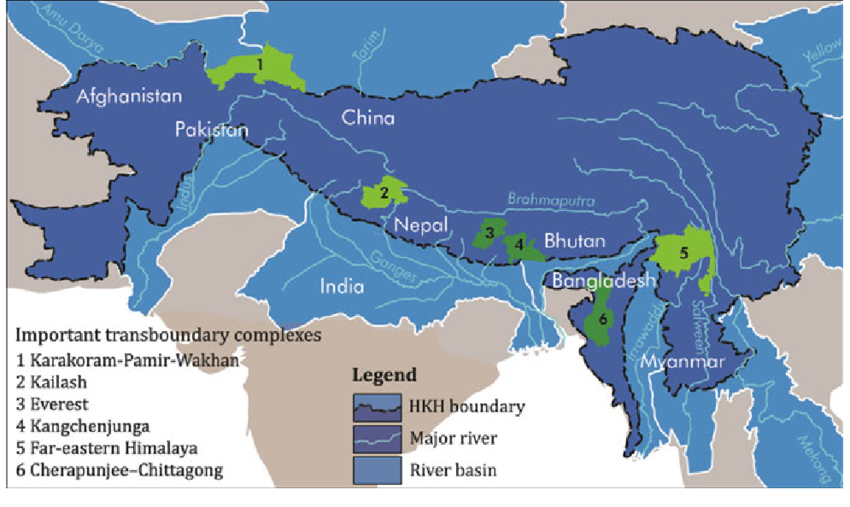Down To Earth (November 01-15-2023)
Economics of Solar Energy Generation
Context:
- Rajasthan leads the country in generation of solar power — a fast growing but costly energy solution for the warming world.
About:
- The cost of solar power has plummeted in recent years, and in many places, it is even cheaper than coal or other fossil fuels. Even with the massive strides made in technological innovation, sustainable energy has not yet replaced traditional fossil fuels.
- In order to incentivize renewable energy adoption, governments have levied tax credits for solar and wind energy, which until recently, were far more expensive than the status quo.
- However, due to increased production, government subsidies, and mounting environmental concerns, the direct costs of solar and wind energy for consumers have decreased.
- In fact, some markets generate renewable energy more cheaply for consumers than fossil fuels. While wind energy is predominantly used for commercial means, solar energy has both commercial and residential uses.
- In fact, some markets generate renewable energy more cheaply for consumers than fossil fuels. While wind energy is predominantly used for commercial means, solar energy has both commercial and residential uses.
Key Takeaways:
|
Economics of Solar Power:
- The cost of solar power falls every year, and it can be cheaper than fossil fuels, depending on the sun and weather conditions in the place of installation.
- By some estimates, solar is now the cheapest form of energy in the United States, with prices as low as $0.70 per watt according to Popular Science.
Fact Sheet:
|
Downsides to Solar Power:
- Solar panels are manufactured from various minerals that must be extracted from the earth.
- This mining process can degrade local ecosystems, just like mining coal and copper.
- In addition, panels have a limited useful lifetime, and they turn into e-waste when they are obsolete.
- In addition, solar power is not ideal for every location—some places have more reliable exposure than others.
Natural Farming
Context:
- A two-day workshop on Natural Farming was organised by Indian Council of Agricultural Research (ICAR).
Why Natural Farming?
- The imbalanced use of chemical fertilisers negatively impacts soil productivity and physical-chemical properties.
- To address this, efforts have been made to promote natural farming, leading to increased livelihoods and production.
About Natural Farming:
- It is a chemical-free farming system rooted in Indian tradition enriched with modern understanding of ecology, resource recycling and on-farm resource optimization.
- It is largely based on on-farm biomass recycling with major stress on biomass mulching, use of on-farm cow dung-urine formulations; maintaining soil aeration and exclusion of all synthetic chemical inputs.
- It is considered as an agro-ecology based diversified farming system which integrates crops, trees and livestock with functional biodiversity.
- Natural farming is expected to reduce dependency on purchased inputs. It is considered as a cost effective farming practice with scope for increasing employment and rural development.

Components of Natural Farming:
- Beejamrit: It is an ancient, sustainable agriculture technique, and used for seeds, seedlings or any planting material.
- Jivamrit: It acts as a biostimulant by promoting the activity of microorganisms in the soil and also the activity of phyllospheric microorganisms when sprayed on foliage.
- Mulching: It is defined as covering of soil surface using both live crops and straw (dead plant biomass) to conserve moisture, lower soil temperature around plant roots, prevent soil erosion, reduce runoff and reduce weed growth.
- Whapasa: It means the mixture of 50% air and 50% water vapour in the cavity between two soil particles.
- Plant Protection:
- Neemastra: It is used to prevent or cure diseases, and kill insects or larvae that eat plant foliage and suck plant sap.
- Neemastra is very easy to prepare and is an effective pest repellant and bioinsecticide for Natural Farming.
- Brahmastra: This is a natural insecticide prepared from leaves which have specific alkaloids to repel pests. It controls all sucking pests and hidden caterpillars that are present in pods and fruits.
- Agniastra: It is used to control all sucking pests and caterpillars.
- Dashaparni Ark or Kashaya: It acts as a substitute for Neemastra, Bramhastra, and Agniastra, and it is used to control all types of pests and used depending on the level of infestation.
- Fungicide: It is prepared with cow milk and curd is found to be very effective in controlling the fungus.
- Neemastra: It is used to prevent or cure diseases, and kill insects or larvae that eat plant foliage and suck plant sap.
Natural Farming and Zero Budget Farming:
- Natural farming approach is sometimes misunderstood as zero-budget, meeting the demands of high-yield farming needs substantial organic supplementation or even cow dung, a crucial component of traditional mixtures.
- Zero-budget natural farming is the process of raising crops without using chemical fertilisers and pesticides or any other external materials.
Case Study: The Andhra Pradesh Community-Managed Natural Farming (APCNF)
Objectives:
|
Issues with Natural Farming:
- According to the Centre for Science and Environment, organic and natural farming in India is still at a nascent stage.
- The main challenges include rapid degradation and pollution of natural resources of land and water, declining soil fertility, pesticide pollution, and the problem of pest-resistance.
- On the other hand, NITI Aayog acknowledges that the main underlying reasons for underdevelopment of agriculture are poor extension, missing link with supply chain of quality seed and quality plant propagation material, low availability of institutional credit in many states, low level of investments in agriculture, and low level of technology.
Other issues involving in Natural Farming:
- Monocropping System: The monocropping system in natural farming can cause considerable damage to the soils biological operation, crop diversity, and soil fertility.
- Increased Cost of Cultivation: Natural farming can lead to an increase in the cost of cultivation, non-remunerative prices for farm produce, and indebtedness.
- Labour Shortages: There can be a migration of agricultural labour to non-farm jobs, leading to labour shortages.
Conclusion:
- Natural Farming methods offer solutions to various problems, such as food insecurity, farmers distress, and health problems arising due to pesticide and fertiliser residue in food and water, global warming, climate change, and natural calamities.
- It also has the potential to generate employment, thereby stemming the migration of rural youth.
Flood-Proof Himalayas
Context:
- There is a urgent need for effective climate change adaptation strategies in the HKH region
About:
- The Himalayan ecosystem is a complex interplay of geology, climate, and life. It is home to numerous glaciers and rivers that provide water to billions of people downstream.
- However, this fragile ecosystem is under threat due to climate change and human activities.
- The mean retreat rate of Hindu Kush Himalayan glaciers is 14.9±15.1 metre/annum (m/a); which varies from 12.7±13.2 m/a in Indus, 15.5±14.4 m/a in Ganga and 20.2±19.7 m/a in Brahmaputra river basins.
- Melting glaciers have a significant impact on the water resources of Himalayan rivers due to changes in glacier basin hydrology, downstream water budget, impact on hydropower plants due to variation in discharge, flash flood, and sedimentation.
The Hindu Kush Himalayan (HKH) region:
|
Reasons for floods in Himalayan region:
- The floods were caused by unrelenting downpours, which were intensified by an erratic climate.
- Unplanned construction on riverbanks, which aggravated the disaster by reducing river navigability and obstructing water flow.
- The simultaneous affliction of diminished river capacity and a compromised drainage system culminated in an inefficient channelling of excess water.
Impacts of hydropower projects in the Himalayan region:
- Disasters linked to hydro power projects have become more frequent in recent years.
- The Himalayas are part of a seismically active zone, and despite the climate and seismic activities in the Himalayas making its river valleys prone to landslides, hydropower projects are mushrooming in the region.
Solutions:
- It emphasises the importance of spatial planning and nature-based solutions to make cities in the Hindu Kush Himalaya (HKH) region climate-resilient.
- It highlights the need for local governments to enforce strict town planning, using spatial land-use planning approaches and associated information technologies for climate change adaptation.
Conclusion:
- In a rapidly changing climate, early warning systems are a critical, cost-effective way of protecting people from extreme weather.
- But effective implementation of the system to protect every person on Earth by 2027, as envisioned by the UN, is a huge task. Countries highly vulnerable to climate change impacts lack the know-how or finance. Technologies, too, need upgrading to accurately predict disasters.
- The Himalayan ecosystem is facing significant challenges due to climate change and human activities. It is crucial to balance development with environmental conservation to ensure the sustainability of this vital ecosystem.
Curbing Sugar Export
Context:
- India extends sugar export curbs because of concern over the rising prices and the impact of a weak monsoon on sugarcane crops.
About:
- The Directorate General of Foreign Trade notified the restrictions would apply to some grades of raw, refined and organic sugar.
- It has moved export of sugar from the open category, which requires no government intervention, to restricted category.
- It means that export of sugar is allowed only with specific permission from the Directorate of Sugar, Department of Food and Public Distribution (DFPD) of Ministry of Consumer Affairs.
- It is to ensure enough supply to meet domestic demand and keep prices under check during the ongoing festival season and the general elections early next year.
- As per the UN Food and Agriculture Organization, global sugar prices soared to their highest level as the El Nino weather phenomenon hit production in India and Thailand.
About sugarcane
Conditions for growth
Distribution
|
Impacts:
- Economic Impact: Indias sugar exports have grown by 291% since 2013-14. The growth was achieved despite logistical challenges posed by the COVID-19 pandemic.
- The decision to regulate sugar exports was taken to maintain domestic availability and prevent a surge in prices amid rising global food and oil prices.
- As India is the world's largest sugar producer and second-largest exporter, the curbs would drive up global sugar prices and food inflation.
- Impact on Farmers: Indian farmers were implicitly taxed $169 billion in 2022 due to export bans, duties or permits on several commodities like wheat and rice, to stabilise prices for consumers.
- Impact on Consumers: The decision to regulate sugar exports was taken to maintain domestic availability and prevent a surge in prices.
- Wholesale prices of sugar in India have been between Rs 3,150 and -Rs 3,500 per quintal; the commodity has been retailing at Rs 36-44 per kilogramme.
Conclusion:
- The decision to ban or restrict sugar exports has significant impacts on the economy, farmers, and consumers. Its a delicate balance between maintaining domestic availability and price stability, and ensuring the welfare of farmers and the growth of the sugar industry.
Unjust Laws Against Climate Activists
Context:
- With the climate crisis deepening, governments world over are clamping down on activists and organisations who are protesting to save the planet.
About:
- As wildfires and extreme temperatures rage across the planet, sea temperature records tumble and polar glaciers disappear, the scale and speed of the climate crisis is impossible to ignore.
- Scientific experts are unanimous that there needs to be an urgent clampdown on fossil fuel production, a major boost in renewable energy and support for communities to rapidly move towards a fairer, healthier and sustainable low-carbon future.
What is the current trend?
- According to climate experts, some political leaders and law enforcement agencies around the world are instead launching a fierce crackdown on people trying to peacefully raise the alarm.
- It has found striking similarities in the way governments from Canada and the US to Guatemala and Chile, from India and Tanzania to the UK, Europe and Australia, are cracking down on activists trying to protect the planet.
- In Australia, several states, including Tasmania, New South Wales and Victoria, have passed or are trying to pass laws that can punish peaceful environmental protesters with hefty fines and jail time.
The Case of UK or USA:
- The legal contexts vary, but the charges – such as subversion, illicit association, terrorism and tax evasion – are often vague and time-consuming to disprove, while a growing number of countries, including the US and UK, have passed controversial anti-protest laws ostensibly intended to protect national security or so-called critical infrastructure such as fossil fuel pipelines.
- Groups like Insulate Britain and Extinction Rebellion (XR) have used non-violent civil disobedience as a vital tool for protest.
- A dangerous moment: No major fossil fuel executive is known to have been detained for their role in the climate emergency, but UN experts, lawyers and activists have documented hundreds of environmental activists being arrested and charged for peacefully protesting to save the planet.
A global phenomenon
- Criminalisation does not happen in isolation.
- Deploying the legal system is part of a spectrum of escalating tactics, including online attacks, defamation, police surveillance, security deployments and violence, deployed by corporations and their allies to divide communities, distract leaders and weaken social movements.
- In India: Activists and NGOs in India face arbitrary criminal charges, surveillance and frozen bank accounts, creating a chilling effect on civil society.
- In the state of Tamil Nadu, police have been accused of excessive force and instigating violence against protesters opposing the expansion of a vast copper smelting plant, which in 2018 resulted in 13 deaths.
Reason:
- The systematic criminalisation of environmental defenders is not new. Natural resources on Indigenous land have long been exploited, driving big profits for some, and fuelling violence and inequality.
- Protests against fossil fuel pipelines, mines, petrochemical plants and other polluting projects ballooning into global movements, such as the Dakota Access Pipeline Protests (2016) on the Standing Rock Indian Reservation in South Dakota.
- Protests against multinational banks financing the East African Crude Oil Pipeline (EACOP), which threatens to pollute vital water sources and displace thousands of families and farmers in Uganda and Tanzania, have taken place in around 20 countries.
- According to the Inter-American Commission on Human Rights (IACHR), criminalising defenders encourages collective stigma and sends off an intimidating message.
Way Forward:
- The climate crisis is exposing and aggravating economic, political and racial inequalities, but eventually the hotter planet will affect everyone, everywhere. Environmental and climate activists are trying to force governments and corporations to put humanity before profits and power.
- Its important to note that non-violence does not seek to undermine the rule of law, only the repeal of unjust laws. Ultimately, its difficult to see how a just transition to net zero could be achieved by unjust means.
Drought in the Amazon
Context:
- Water levels at Manaus river port, one of Brazil's most populous cities in the Amazon rainforest, have dropped to their lowest level in at least 121 years.
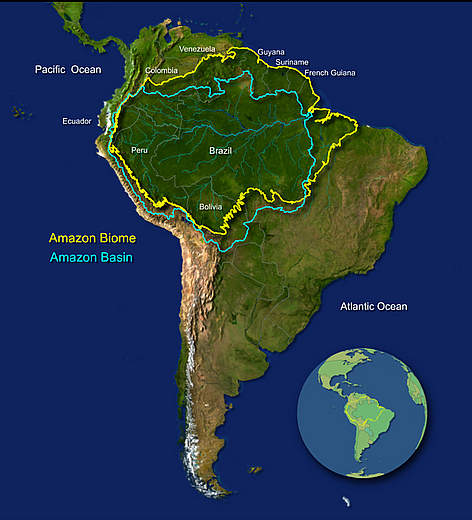
What has triggered the acute drought?
- The Amazon rainforest, often referred to as the planets lungs, is currently experiencing a severe drought.
- Government of Brazil has attributed the ongoing drought to the onset of El Nino, a climate phenomenon that is causing extreme weather patterns around the world.
Factors:
- El Nino Effect: This weather phenomenon has been particularly strong this year, exacerbating the drought conditions.
- Decreased Rainfall: Some areas of the Amazon have seen the least rain from July to September since 1980.
- Climate Change: The ongoing climate crisis has led to changes in weather patterns, contributing to the severity of the drought.
- Human Activities: Works of enormous environmental impact are also contributing to the situation.
Impacts:
- The drought has led to numerous rivers vital for travel drying up, disrupting the lives of tens of thousands of Indigenous people.
- The Rio Negro, one of the worlds largest rivers by discharge levels, has fallen to a record low level.
- The lack of water has stalled the operations of a major hydropower dam in the region and left tens of thousands of people stranded in remote jungle villages, with limited access to food, and other supplies.
- The extreme dry conditions have also made the rainforest more vulnerable to wildfires. High numbers of fish and river dolphins, known as boto, have been washing up dead, contaminating the water supply in some areas.
Is the situation likely to worsen?
- Scientists have in the past established that climate change has led to a rise in drought and extreme heat, priming forests to burn more often.
- On top of this, deforestation and the expansion of agriculture have damaged the integrity of the Amazon's forests and weakened their resilience to drought. As a result, the frequency of wildfires have increased.
- Previous spikes in fire counts, including the record-breaking fires for a non-drought year in August and September 2022, were associated with widespread deforestation.
The Impact of Disasters on Agriculture and Food Security 2023
Context:
- The Impact of Disasters on Agriculture and Food Security published by FAO, provides a timely and comprehensive overview of how disasters are affecting agriculture and food security around the world.
About:
- According to a report by the UN Food and Agriculture Organization (FAO), an estimated $3.8 trillion worth of crops and livestock production has been lost due to natural disasters over the last 30 years, with Asia experiencing the largest share of the total economic losses.
- The loss corresponded to an average of $123 billion per year, or 5% of annual global agricultural GDP.
Do you know?
|
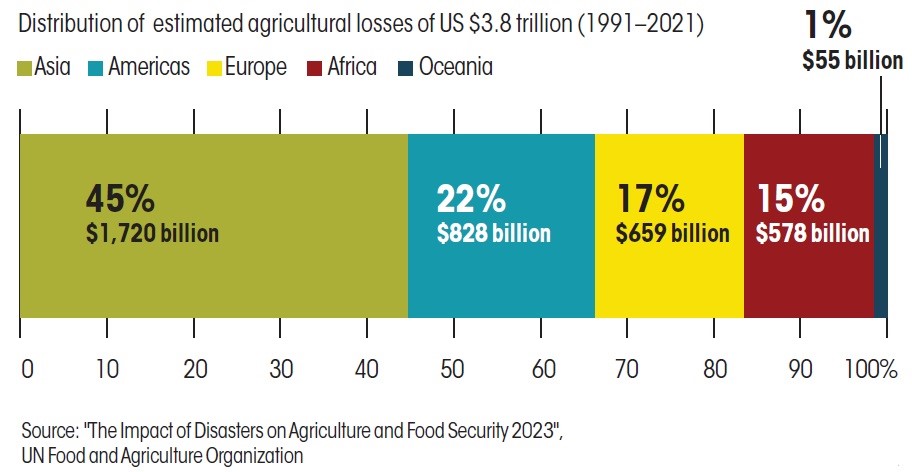
Key Findings:
- The report estimates losses caused by disasters on agricultural production over the past three decades and delves into the diverse threats and impacts affecting the crops, livestock, forestry, and fisheries and aquaculture subsectors.
- It analyses the complex interplay of underlying risks, such as climate change, pandemics, epidemics, and armed conflicts, and how they drive disaster risk in agriculture and agrifood systems at large.
- The report makes a powerful case for investing in resilience and disaster risk reduction – especially data gathering and analysis for evidence-informed action – to ensure agricultures crucial role in achieving the future we want.
- The findings show that the 78 disasters caused a total of US$140 billion in damage and losses on all sectors, of which US$30 billion was in the agriculture sector and sub–sectors.
- On average, agriculture absorbs 22% of the total economic impact caused by natural hazards.
Impact of extreme events on agriculture:
- Agriculture around the world is increasingly at risk of being disrupted due to multiple hazards and threats such as flooding, water scarcity, drought, declining agricultural yields and fisheries resources, loss of biological diversities and environmental degradation.
- Variations in water supply and extreme temperatures are two of the biggest factors that directly and indirectly impact agricultural production.
- Agricultural drought emerges from a combination of rainfall deficits (meteorological drought), soil water deficits, and reduced ground water or water storage levels needed for irrigation (hydrological drought).
- A recent study found that the severity of heatwave and drought impacts on crop production roughly tripled from 2.2% between 1964 and 1990, to 7.3% between 1991 and 2015.
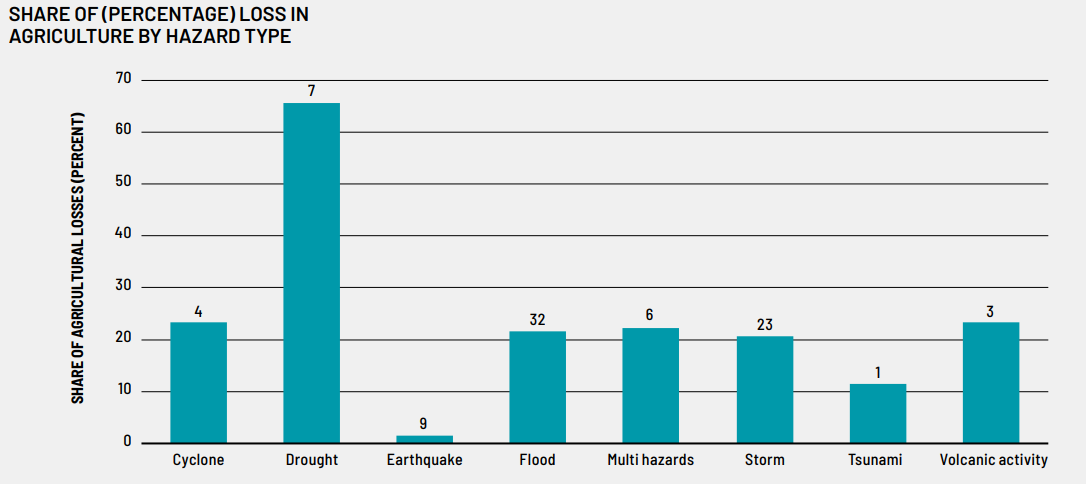
Conclusion and Way Forward:
- The study argues that to build resilient agrifood systems, it is essential to understand interconnected and systemic risks and underlying disaster risk drivers.
- Investment in enhanced data monitoring, reporting and collection methodologies and tools is an essential first step in building national capacities to understand and reduce disaster risks in agriculture and wider agrifood systems.
- Disaster impacts are worsened by multiple drivers and overlapping crises that produce cascading and compounding effects and worsen the exposure and vulnerability of people, ecosystems and economies.
- There is a need to develop and mainstream multi sectoral and multi hazard disaster risk reduction approaches into policy and decision making.
- There is a need for investments in resilience that provide benefits in reducing disaster risk in agrifood systems and improve agricultural production and livelihoods.
Invasive Species
Context:
- As per a study published in the Journal of Applied Ecology, about 66% of India's natural systems are threatened by invasive species.
About:
- It is natural for plants and animals to move across habitats and ecosystems. But when they move at greater rates—either with humans deliberately shifting them for profit, or by inadvertent transport through global shipments—a biological invasion is initiated.
- There is no place on the planet that remains untouched by biological invasion, which is also driving thousands of species into extinction.
- Spread of invasive alien species does not just threaten survival and well-being of biodiversity, but also imposes huge costs across the world.
Invasive species:
|
Triple burden of Biological Invasion:
- Extinctions: Invasive alien species have contributed solely or alongside other drivers of change to 60% of recorded global extinctions of which 90% occurred on islands. 218 invasive alien species caused 1,215 local extinctions of native species.
- Adverse quality of Life: Invasive alien species have a negative impact on good quality of life in 85% of cases.
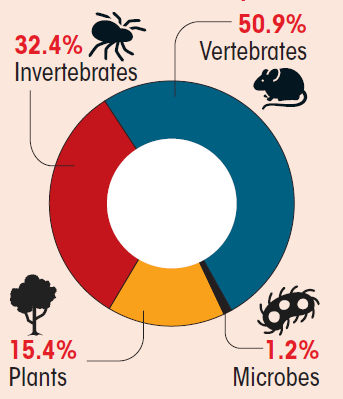
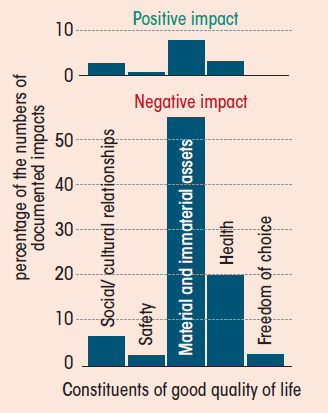

- Economic Cost: The economic cost of biological invasion of species increased fourfold every decade. In 2019, the estimated global annual economic cost of biological invasions was $423 billion.
- It is estimated around US $423 billion to cost the world, in which nearly 92% accrue from the negative impact of invasive alien species on natures contributions to people or on good quality of life, while nearly 8% of that sum is related to management expenditures of biological invasions.
- Invasive alien species can add to marginalisation and inequality, including, in some contexts, gender and age-differentiated impacts.
Green Credit Rules, 2023
Context:
- The Green Credit Rules, 2023 were introduced as part of the LiFE (Lifestyle for Environment) movement.
About:
- To take ahead the 'LiFE' - 'Lifestyle for Environment' movement, the Union Ministry of Environment, Forest and Climate Change (MoEFCC) has introduced two pioneering initiatives that indicate the country's proactive approach to climate change, sustainability and promotion eco-conscious practices:
- The Green Credit Program (GCP); and
- The Ecomark Scheme.
- These seek to encourage environmentally friendly practices rooted in tradition and conservation; reflecting the ideas of LiFE concept.
- The Green Credit Program (GCP) is an innovative market-based mechanism designed to incentivize voluntary environmental actions across diverse sectors, by various stakeholders like individuals, communities, private sector industries, and companies.
- The GCP focuses on two key activities:
- Water conservation; and
- Afforestation.
- The rules were introduced under 'Green Credit Programme Implementation Rules 2023'.
What is Green Credit?
- 'Green Credit' means a singular unit of an incentive provided for a specified activity, positively impacting the environment.
- Whenever an individual or institution acts positively to benefit the environment, the activity is credited to him as green credit.
- Green Credits earned in such a manner are then made available in the market and transferred from one entity to another by trading.
Key Objectives of Green Credit Rules:
Incentivizing Environmentally Positive Actions:
- The primary goal of the Green Credit Program is to incentivise actions that positively impact the environment.
- This is achieved through a market-based mechanism where participants are rewarded with green credits for undertaking specific environmentally friendly activities.
Creation of Tradable Green Credits:
- The program is designed to generate green credits based on environmentally conscious actions undertaken by individuals or entities. These green credits are made tradable on a domestic market platform, allowing those who have earned them to trade or sell them to other entities in the market.
Encouraging Compliance and Voluntary Measures:
- The Green Credit Program encourages industries, companies, and other entities to fulfil their environmental obligations as existing laws require.
Exclusion of Tradable Obligation-based Credits:
- The green credits generated or acquired to fulfil legal obligations cannot be traded. It ensures that the program remains focused on incentivizing voluntary environmental actions.
Pink Bollworm
Context:
- Farmers across cotton-growing states are struggling to manage the pink bollworm (PBW) pest that is wreaking havoc, resulting in heavy economic losses.

About Pink Bollworm (PBW):
- Pink Bollworm (Pectinophora Gossypiella) is a significant pest that primarily affects cotton crops.
- It damages parts of the developing cotton fruit, like the square (the flower bud) and the boll (rounded sac of seeds with cotton fibres).
Concerns
- Indian farmers have faced consistent losses of Bt cotton crops due to pink bollworm attacks since the mid-2000s, when scientists found that the insect had become resistant to Cry1Ac gene and the genetically modified variety of cotton.
- Bt cotton was introduced to India in 2002 after its success in the United States and Australia in 1996.
- Another major pest affecting cotton is the Fruit borer.
Growing Resistance:
1970s:
1980s:
2000s:
2010s:
2020s:
|
Solution
- Cotton Pest Dynamics: It refers to the study of the population behaviour of pests that affect cotton crops, which involves understanding the factors that influence pest populations and developing strategies to manage them effectively.
Agriculture: Easy Targets to Cut Emissions
Context:
- High-income nations across the world appear focused on agriculture as the sector to enforce emissions cut for meeting national climate goals.
About:
- Agricultural production emissions arise from livestock farming, application of nitrogen fertilisers, rice cultivation, and energy use.
- Methane (from livestock belching, flatulence and dung) and nitrous oxide (from nitrogen fertilisers) are the two main greenhouse gases (GHGs) from the agriculture sector.
- Emissions and storage from soil carbon (which is counted in land use) and farm energy use are not counted as part of agricultural emissions.
- As per US Environmental Protection Agency, methane and nitrous oxide account for 16% and 6% of global GHGs.
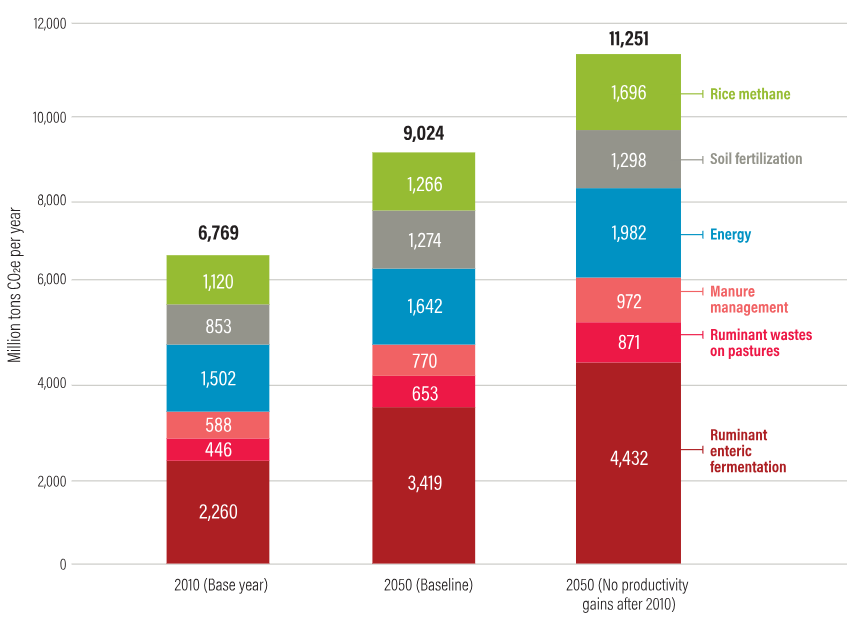
Rationale Behind Farm Focus:
|
Treaties to deal with agricultural emissions:
- The Global Methane Pledge (GMP): It has been signed by 149 countries since its launch in 2021 at the Conference of the Parties (COP) to United Nations Framework Convention on Climate Change held at Glasgow, Ireland.
- The signatory nations have pledged to cut methane emissions by 25% by 2030 compared to 2020 levels.
- The European Green Deal: It is signed by 27 countries, which are required to reduce their GHG emissions by at least 55 % by 2030 compared to 1990 levels.
- A Nature Restoration Law aims to restore and recover nature on at least 20% of EU land and sea area by 2030, through binding targets relating to habitat and species restoration.
Methane Primer:
|
Flash Floods
Context:
- The world saw two major flash floods in September- October—one in Libya and the other in Sikkim, India.
- While the Libya event was predicted but could not be disseminated, there was no forecast for the Sikkim flood.
About:
- A devastating flood in Libya after unprecedented rainfall caused the collapse of dams in one of its driest regions.
- The trigger for this colossal disaster was a rare Medicane, a hurricane-like tropical storm in the Mediterranean Sea, called Daniel.
- Daniel caused extraordinary rainfall that created many temporary lakes and streams in the largely desert country. It caused a flood in Wadi Derna, a dry riverbed, which led to breach of two dams i.e. Al-Bilad and Abu Mansour—increasing the intensity of the flood to catastrophic levels downstream till the coast.
- Medicane Daniel caused heavy floods in Libya.
Flash Flood:
|
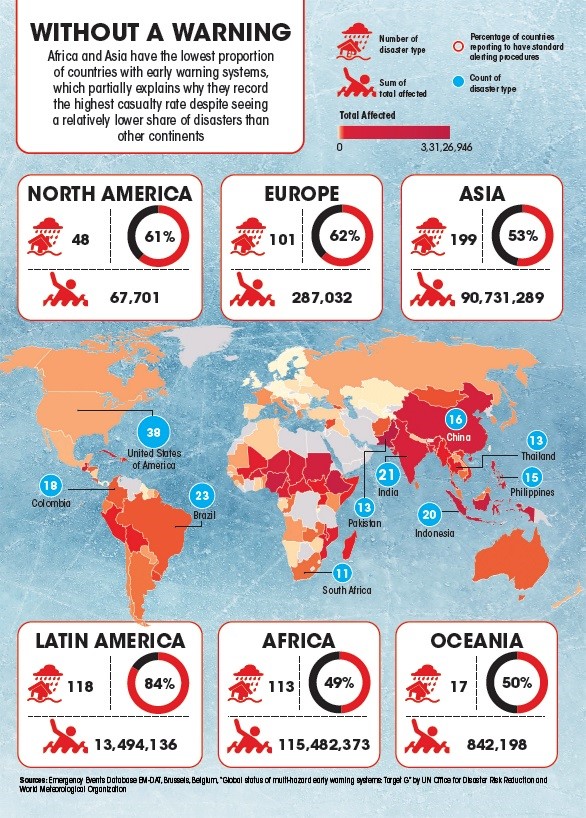
Flood Early Warning Systems (FEWSs):
- These are an important component of disaster risk management strategies, and are designed to issue warnings when a flood is imminent or already occurring.
- FEWSs play a crucial role in mitigating the impact of floods by providing timely warnings and enabling effective responses.
- A comprehensive FEWS consists of four components:
- Risk Knowledge: Understanding and mapping the area at risk.
- Monitoring and Forecasting: Keeping track of the factors that can trigger a flood.
- Warning, Dissemination, and Communication: Ensuring the warning reaches all those at risk.
- Response Capabilities: The ability of communities and individuals to react effectively to a warning.
- There are apparent differences in sophistication between FEWSs in developed countries that have the financial capabilities, technological infrastructure, and human resources and developing countries where FEWSs tend to be less advanced.
- Fortunately, recent advances in remote sensing, artificial intelligence (AI), information technologies, and social media are leading to significant changes in the mechanisms of FEWSs and provide the opportunity for all FEWSs to gain additional capability.
- For instance, in Assam, India, a Flood Early Warning System has been implemented, which includes major technical components like the meteorological component and the hydrological component. This system has been successful in mitigating disasters during floods.
Information Dissemination:
- Dissemination is done mainly via concerned government departments at the national, state and district levels. It is also done through print/digital/social media even to individual users through digital applications.
- However, timely dissemination of early warnings to impacted communities is a major challenge, compounded by gaps in connectivity. Spreading awareness about steps to take during a disaster event also lacks focus.
Predicting Disasters:
GLOFs (Glacial Lake Outburst Floods):
Floods:
Drought:
Cyclone:
|
Restoring and Rejuvenating Sahibi River
Context:
- Delhi is making efforts to bring back the Sahibi, but the river's true rejuvenation will require collaborative efforts from the neighbouring states of Rajasthan and Haryana.
About:
- Sahibi river in Delhi (aka the Najafgarh drain), runs from Rajasthan to Delhi via Haryana. This revival process envisions cleaning, desilting and embankment restoration.
- Origin: Eastern slopes of the Saiwar hills in the Neem ka Thana district of Rajasthan.
- A large part of the riverbed in Rajasthan and Haryana remains parched and, in several areas, shows no visible trace.
- The mapping, which involved analysis of satellite images, topographical sheets and administrative maps using gis software, established that the river spans around 317 km.
River restoration
|
Steps for restoration:
- Identification of the river's original path through palaeo-channel mapping: It was done with contributions from concerned citizens.
- Managing Catchments: The Catchment-Based Approach is a community-led approach that engages individuals and organisations from across society to improve freshwater environments.
- Restoring a more natural river course: River straightening, diverting and over-deepening has been common practice in the past, to create space for land development, enhance river navigation, improve land drainage and reduce flooding.
- Re-meandering reinstates a more natural course and river profile with the aim of improving habitat diversity and biodiversity.
- Floodplain reconnection and wetland creation: Floodplains are an important aspect of a riverine environment, providing flood storage, fish refuge and habitat diversity but often they have been disconnected and drained to protect housing from flooding and create land for agriculture or development.
- Removing or passing barriers: Barriers such as weirs and dams are common features of the riverine landscape.
- Barriers can restrict the passage of wildlife along a river, and alter river habitats by creating deeper and slower flows directly upstream.
PRELIMS
Katkari Tribe
Context:
- Ghera Sinhagad Van Sanrakshan Samiti Initiative to protect Sinhagad fort & forest in Maharashtra helps people earn a livelihood.
About Katkari Tribe:
- Katkari is one of the 75 Particularly Vulnerable Tribal Groups (PVTGs), as per the classification by the Ministry of Home Affairs.
- It is a primitive tribe found in the Sahyadri mountain range in Maharashtra and parts of Gujarat.
Occupation:
- Katkaris, aka Kathodis, are known for their old occupation of making Katha (Catechu) the thickened sap from wood of Khair (Acacia Catechu).
- They serve as agricultural labourers and sell firewood and some jungle fruits. They also take up fishing for domestic consumption, coal making and brick manufacturing.
Issues:
- Poor literacy rates, health conditions and minimal livelihood opportunities are some of the issues faced by the tribal people.
Asteroid Psyche
Context:
- NASA launched a satellite on a 3.6-billion-km journey to a metal-rich asteroid Psyche that lies between the orbits of Mars and Jupiter.
About:
- Asteroid Psyche is the largest known metallic object in the solar system, located about three times farther away from the Sun than Earth.
- Psyche orbits the Sun between Mars and Jupiter at a distance ranging from 235 million to 309 million miles from the Sun.
- Psyche takes about five Earth years to complete one orbit of the Sun, but it takes just over four hours to rotate once on its axis (a Psyche day).
Asteroids:
|
Composition:
- The scientific consensus was that Psyche consisted mostly of metal.
- However, more recent data indicates that the asteroid is possibly a mix of metal and silicate, the same material found in glass and sand.
- The best analysis indicates that Psyche is likely made of a mixture of rock and metal, with metal composing 30% to 60% of its volume.
NASAs Psyche Mission:
- It is set to explore this intriguing asteroid.
- The Psyche spacecraft will travel to the asteroid using solar-electric (low-thrust) propulsion, following a Mars flyby and a gravity assist.
- Once in orbit, the spacecraft will map and study Psyche using a multispectral imager, a gamma-ray and neutron spectrometer, a magnetometer, and a radio instrument (for gravity measurement).
- The missions goal is, among other things, to determine whether Psyche is indeed the core of a planetesimal.
CONICET: Scientific and Technical Research Council of Argentina
Context:
- Javier Milei, a libertarian Presidential candidate, has promised to shut down the country's main science agency, CONICET.
About:
- Javier Milei believes that scientific research should be privately funded and that shutting down CONICET could help end Argentina's fiscal crisis.
CONICET:
- It is the main government agency that fosters the development of science and technology in Argentina.
- It is one of the most important assets of the country in terms of science and technology.
- It comprises researchers of all disciplines who work in national universities, scientific and technological research organisms, Implementation Units or other institutions.
- It promotes research, and scientific and technological development in the whole country.
- Currently, the Council has more than 11,800 researchers, 11,600 doctoral and postdoctoral fellows, more than 2,900 technicians and professional support staff, and 1,400 administrative employees.
Great areas of knowledge of CONICET
- Agrarian, Engineering and Material Sciences;
- Biological and Health Sciences;
- Exact and Natural Sciences; and
- Social Sciences and the Humanities
Mountain Chicken Frogs
Context:
- As per the survey, mountain chicken frog is believed to be one of the fastest extinctions of a wild animal on record.
About the mountain chicken frog (Leptodactylus Fallax):

- It was once so abundant in Dominica, with thousands found across the island.
- The species once lived across seven Caribbean islands, but researchers believe that Dominica is the last place on Earth where the frogs can be found in the wild.
- The population of mountain chicken frogs in Dominica has shrunk from hundreds of thousands to 21 in just two decades.
- According to the Zoological Society of London (ZSL), the species population has declined over 99% since 2002 when Chytridiomycosis struck.
- Chytridiomycosis is a fungal infectious disease that affects more than 500 frog species across the world, and it has caused 90 extinctions of species within the past 50 years.
IUCN Status:
- Mountain chicken frogs Leptodactylus fallax are assessed as Critically Endangered on the IUCN Red List due to threats including chytridiomycosis and habitat loss.
Global Hunger Index (GHI)
Context:
- The Concern Worldwide and Welthungerhilfe introduced the GHI for 2023.
About:
- India's standing on the Global Hunger Index (GHI) fell to 111 out of 125 countries in 2023, with a score of 28.7 on a 100-point scale where 0 is the best score (no hunger) and 100 is the worst. This categorises Indias severity of hunger as serious.
- The country was ranked 109 out of 125 in 2015; 94 out of 107 in 2021; and 107 out of 121 in 2022.
- The majority of the countries below India are either undergoing civil war or reeling from the effects of external assault.
Global position:
- India is positioned after neighbouring countries Pakistan (102nd), Bangladesh (81st), Nepal (69th) and Sri Lanka (60th).
- Afghanistan, Haiti and 12 sub-Saharan countries perform worse than India on the GHI.
Stagnation in the fight against global hunger:
- According to the GHI 2023 report, the stagnation in the fight against global hunger is largely due to the combined effects of overlapping crises, including the COVID-19 pandemic, the Russia-Ukraine war, economic stagnation, the impacts of climate change, and the intractable conflicts facing many countries of the world.
Chimeric Antigen Receptor (CAR) T-Cell Therapy
Context:
- The Central Drugs Standard Control Organisation approved India's first Chimeric Antigen Receptor (CAR) T-Cell Therapy for the treatment of relapsed-refractory B-cell lymphoma and leukaemia.
NexCAR19:
- It is an indigenously developed CD19-targeted CAR-T cell therapy.
- CD-19 is a B cell biomarker that can be used as a target for leukaemia immunotherapies.
CAR- T Cell Therapy:
- For CAR-T-cell therapy, blood is first drawn from the patient. Then, immune cells called T-cells are genetically modified in a laboratory and are injected back into the patient to enable the cells to locate and destroy cancer cells more effectively.
Significance:
- Patients in India and countries with limited resources will have access to this life-saving drug at an affordable cost.
- Abroad, the CAR-T cell therapy costs around ₹3-4 crore per patient. The NexCAR19 will be ₹30-40 lakh per patient, which is 1/10th of the cost abroad.
- In terms of technical achievement, it puts India on the elite list of select countries that have access to CAR-T therapy.
External Debt Repayment
Context:
- More than 60% of low-income countries are spending more on external debt repayment than on public healthcare.
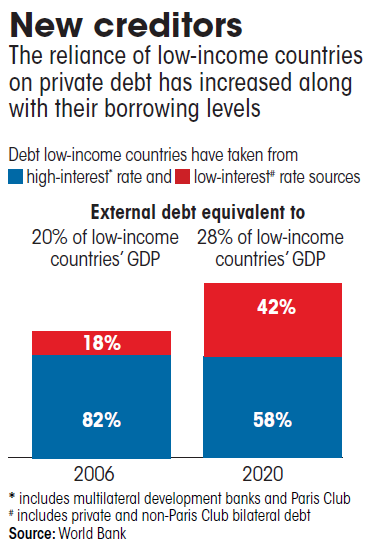
About:
- About 41 low-income countries spend more on external government debt payments in 2019 than on public healthcare.
- About 7 low-income countries spend almost equally on external government debt payments and public healthcare.
- About 17 low-income countries spend less on external government debt payments than on public healthcare.
Heavily Indebted Poor Countries (HIPC) initiative:
- In 1996, IMF and the World Bank launched the Heavily Indebted Poor Countries (HIPC) initiative, under which countries were offered 100% relief on debts if they commit to policy changes to reduce poverty.
- Following the initiative, countries spent about five times more on health, education and other social services than on debt repayment.
External debt:
|
Subjective Questions
- How natural farming techniques are vital for sustainable agricultural practices? What are the major challenges faced by farmers in practising natural farming?
- How far do you think climate related disasters impact the agriculture and food system?
- What do you understand about the Green Credit and evaluate the Green Credit Rules of 2023.
- What are the prospects and challenges involved in cultivating cotton in India?
- Flash floods are common these days. How far do Early Warning Systems help to reduce the flash floods?
QUICK LINKS
